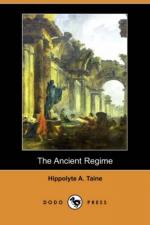This vast supply of positive or probable facts, either demonstrated or anticipated, furnishes food, substance and impulse to the intellect of the eighteenth century. Consider the leaders of public opinion, the promoters of the new philosophy: they are all, in various degrees, versed in the physical and natural sciences. Not only are they familiar with theories and authorities, but again they have a personal knowledge of facts and things. Voltaire[8] is among the first to explain the optical and astronomical theories of Newton, and again to make calculations, observations and experiments of his own. He writes memoirs for the Academy of Sciences “On the Measure of Motive Forces,” and “On the Nature and Diffusion of Heat.” He handles Réamur’s thermometer, Newton’s prism, and Muschenbrock’s pyrometer. In his laboratory at Cirey he has all the known apparatus for physics and chemistry. He experiments with his own hand on the reflection of light in space, on the increase of weight in calcified metals, on the renewal of amputated parts of animals, and in the spirit of a true savant, persistently, with constant repetitions, even to the beheading of forty snails and slugs, to verify an assertion made by Spallanzani. - The same curiosity and the same preparation prevails with all imbued with the same spirit. In the other camp, among the Cartesians, about to disappear, Fontenelle is an excellent mathematician, the competent biographer of all eminent men of science, the official secretary and true representative of the Academy of Sciences. In other places, in the Academy of Bordeaux, Montesquieu reads discourses on the mechanism of the echo, and on the use of the renal glands; he dissects frogs, tests the effect of heat and cold on animated tissues, and publishes observations on plants and insects. — Rousseau, the least instructed of all, attends the lectures of the chemist Rouelle, botanizing and appropriating to himself all the elements of human knowledge with which to write his “Emile.” — Diderot taught mathematics and devoured every science and art even to the technical processes of all industries. D’Alembert stands in the first rank of mathematicians. Buffon translated Newton’s theory of flux, and the Vegetable Statics of Hales; he is in turn a metallurgist, optician, geographer, geologist and, last of all, an anatomist. Condillac, to explain the use of signs and the relation of ideas, writes abridgments of arithmetic, algebra, mechanics and astronomy.[9] Maupertuis, Condorcet and Lalande are mathematicians, physicists and astronomers; d’Holbach, Lamettrie and Cabanis are chemists, naturalists physiologists and physicians. — Prophets of a superior or inferior kind, masters or pupils, specialists or simple amateurs, all draw directly or indirectly from the living source that has just burst forth. This is their basis when they begin to teach about Man, what he is, from whence he came, where he is going, what he may become and what he should be. A new point of departure leads to new points of view; so that the idea, which was then entertained of the human being will become completely transformed.




